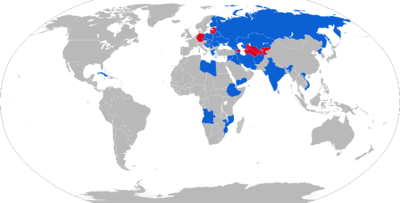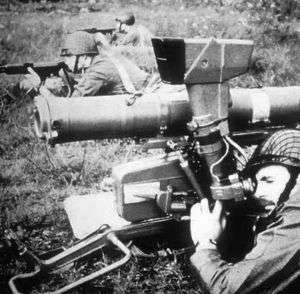9K111 Fagot
| 9K111 Fagot | |
|---|---|
|
Polish anti-armor team with the 9K111 Fagot. | |
| Type | Anti-tank weapon |
| Place of origin | Soviet Union |
| Service history | |
| In service | 1970–present |
| Used by | See Users |
| Wars | 2008 South Ossetia war,[1] War in Donbass, Syrian civil war, Iraq War (2014–present) |
| Production history | |
| Designer | Tula Machinery Design Bureau (Tula KBP) |
| Designed | 1962 |
| Produced | 1970 |
| Variants | See Models |
| Specifications | |
| Weight | 12.5 kg (28 lb) |
| Length | 1,100 mm (3 ft 7 in) |
| Diameter | 120 mm (4.7 in) |
|
| |
| Action | 400 mm versus RHA or 200 mm towards armour inclined at 60° |
| Rate of fire | 3 rds / min |
| Muzzle velocity |
80 m/s (180 mph; 290 km/h) at launch 186 m/s (420 mph; 670 km/h) in flight speed |
| Effective firing range | 70–2,500 m (230–8,200 ft) |
| Warhead | High Explosive Anti-Tank (HEAT) warhead |
| Warhead weight | 1.7 kg High Explosive Anti-Tank (HEAT) |
|
| |
Guidance system | SACLOS wire-guided missile |
The 9K111 Fagot (Russian: Фагот; "bassoon") is a second-generation tube-launched SACLOS wire-guided anti-tank missile system of the Soviet Union for use from ground or vehicle mounts. The 9K111 Fagot missile system was developed by the Tula KBP Design Bureau for Instrument Building. "9M111" is the GRAU designation of the missile. Its NATO reporting name is AT-4 Spigot.
Development
The 9K111 Fagot was developed by the Tula Machinery Design Bureau (Tula KBP). Development began in 1962 with the aim of producing the next generation of SACLOS ATGMs for use in both the man portable role and the tank destroyer role. The 9K111 Fagot was developed alongside the 9M113 Konkurs; both missiles use similar technology – only differing in size – and can use the same launchers.
The missile entered service in 1970.
History
The anti-tank platoon of a Soviet BTR equipped motor rifle battalion had two (sometimes three)[2] ATGM squads, each with two 9K111 Fagot teams. The team consisted of three men – the gunner carries the 9P135 launcher and tripod as a back pack – the other two men each carry two launch tubes. The men also carry assault rifles, but do not carry an RPG – because, unlike the earlier missiles, there is only a small deadzone within which the missile cannot engage the target. Besides the four missiles carried by each team, each squad would normally have an extra eight missiles carried in their transport, usually a BTR. It can also be deployed from the BMP-1P, BMD-1P, BTR-D and UAZ-469.
North Korea was said to have acquired a number of the systems during the late 1980s till 2000s from the USSR. These were subsequently reverse-engineered under the designation Bulsae-2.[3] A further upgrade called the Bulsae-3 was introduced in 2016 that replaced the wire-guidance with laser guidance, which gives greater range while being less susceptible to jamming like wireless radio-guidance and enables the designator to be separate from the launcher.[4][5]
Description

The missile is stored and carried in a container/launch tube. It is fired from a 9P135 launcher post – a simple tripod. A 9S451 guidance box is fitted to the tripod – with the missile sitting just above. The 9Sh119 sight is fitted to the left side (from the gunner's POV). The complete launcher system weighs 22.5 kg (50 lb). The gunner lays prone while firing. The system can engage moving targets, provided that they are travelling at less than 60 km/h (37 mph). The launcher post can traverse through 360 degrees horizontally, and +/− 20 degrees in elevation. The sight has a magnification of 10x and a 5 degree field of view. Up to three missiles a minute can be fired from a launcher post.
The system uses a gas generator to push the missile out of the launch tube – the gas exits from the rear of the launch tube in a manner similar to a recoilless rifle. The missile leaves the launch tube at 80 m/s (180 mph; 290 km/h). It is quickly accelerated to 186 m/s (420 mph; 670 km/h) by its solid fuel motor. This initial high speed reduces the missile's deadzone, since it can be launched directly at the target, rather than in an upward arc.
The launcher tracks the position of an incandescent infrared bulb on the back of the missile relative to the target – and transmits appropriate commands to the missile via a thin wire that trails behind the missile. The SACLOS guidance system has many benefits over MCLOS, with the accuracy of the system stated as 90% in some sources, though its performance is probably comparable to the TOW or the later SACLOS versions of the 9K11 Malyutka.
Models

Missile
- 9M111 Fagot (NATO: AT-4 Spigot and AT-4A Spigot A) Entered service in 1970. Maximum range 2,000 m (6,600 ft; 1.2 mi), minimum 70 m (230 ft). Warhead 400 mm versus RHA or 200 mm towards armour inclined at 60°[6]
- 9M111-2 Fagot (NATO: AT-4B Spigot B) Slightly improved version.
- 9M111M Faktoriya/Faktoria[7] (Trading post) or Fagot-M (NATO: AT-4C Spigot C) Improved motor, longer guidance wire. Maximum range 2,500 m (8,200 ft; 1.6 mi), mimimum 75 m (246 ft). Improved single HEAT warhead; penetration 400 mm versus RHA or 230 mm towards armour inclined at 60°[6][8][9] (some publications claimed 9M111M to have tandem HEAT warhead).
Launcher
- 9P135 22.5 kg (50 lb). Can only fire the 9M111 Fagot series.
- 9P135M Can fire the 9M111 Fagot (NATO: AT-4 Spigot) series as well as the 9M113 Konkurs (NATO: AT-5 Spandrel) series missiles.
- 9P135M1 Updated version of the 9P135.
- 9P135M2 Updated version of the 9P135.
- 9P135M3 Deployed in the early 1990s. Adds 13 kg (29 lb) TPVP thermal imaging night sight – range 2,500 m (8,200 ft; 1.6 mi) at night.
- 9S451M2 A launcher with a night sight featuring an anti-dazzle system has been developed.
Operators

Current operators
-
 Afghanistan – 100
Afghanistan – 100 -
 Algeria – 2040 delivered between 1995-1996 For BMP-2 IFV.[10]
Algeria – 2040 delivered between 1995-1996 For BMP-2 IFV.[10] -
 Angola – 100
Angola – 100 -
 Armenia[11]
Armenia[11] -
 Azerbaijan
Azerbaijan -
 Bosnia and Herzegovina – 52
Bosnia and Herzegovina – 52 -
 Belarus – 500
Belarus – 500 -
 Bulgaria – 222
Bulgaria – 222 -
 Croatia – 119
Croatia – 119 -
 Cuba – 100
Cuba – 100 -
 Czech Republic – 50
Czech Republic – 50 -
 Ethiopia – 50
Ethiopia – 50 -
 Finland – Several hundred 9P135M-1 launchers (withdrawn from service) and AT-4B as well as AT-5A missiles, known as PstOhj 82 and PstOhj 82M respectively.
Finland – Several hundred 9P135M-1 launchers (withdrawn from service) and AT-4B as well as AT-5A missiles, known as PstOhj 82 and PstOhj 82M respectively. -
 Georgia[12]
Georgia[12] -
 Greece – 262 (acquired from former East German stocks)
Greece – 262 (acquired from former East German stocks) - Hamas [13]
-
 Hungary – 50
Hungary – 50 - Islamic State of Iraq and Levant – Unknown number captured
-
 India – 100
India – 100 -
 Iran
Iran -
 Iraq – used by Iraqi Kurdistan this era
Iraq – used by Iraqi Kurdistan this era -
 Kazakhstan
Kazakhstan -
 Kuwait – 100
Kuwait – 100 -
 Libya – 100
Libya – 100 -
 Moldova – used on BMP-1
Moldova – used on BMP-1 -
 Mozambique – 10
Mozambique – 10 -
 North Korea – Unknown, reversed engineered under designation of Bulsae-2
North Korea – Unknown, reversed engineered under designation of Bulsae-2 -
 Poland – 100
Poland – 100 -
 Romania – acquired in the 1980s
Romania – acquired in the 1980s -
 Russia – 1,000
Russia – 1,000 -
 Serbia – 250
Serbia – 250 -
 Slovakia – 50
Slovakia – 50 - Free Syrian Army and other rebel groups – large numbers[7]
-
 Syria – 100
Syria – 100 -
 Ukraine – 800
Ukraine – 800 -
 Yemen – 100
Yemen – 100 -
 Vietnam
Vietnam
Former operators
-
 Czechoslovakia – all transferred to both successors after Dissolution of Czechoslovakia.
Czechoslovakia – all transferred to both successors after Dissolution of Czechoslovakia. -
 East Germany – Passed on to Germany after the German Reunification.
East Germany – Passed on to Germany after the German Reunification. -
 Germany – all retired soon after German Reunification.
Germany – all retired soon after German Reunification. -
 Slovenia – replaced by Spike missile.
Slovenia – replaced by Spike missile. -
 Soviet Union – passed to successor states.
Soviet Union – passed to successor states.
See also
References
- ↑ http://www.utro.ru/articles/2008/08/20/761041.shtml
- ↑ Owen, Garry. "MRB Anti-Tank Platoon (APC)". Red Guards Index. Retrieved 16 May 2014.
- ↑ https://fas.org/nuke/guide/dprk/nkor.pdf
- ↑ North Korea has upgraded old anti-tank missile with laser guided system called Bulsae-3 - Armyrecognition.com, 4 March 2016
- ↑ North Korea Says Its New Missile Can Turn Tanks Into "Boiled Pumpkins" - Popularmechanics.com, 29 February 2016
- 1 2 Maksim Sayenko. "Bronya »krylyatoy pyekhoty«" (Armour of "Winged infantry"). Tekhnika i Vooruzhenie no.02/2007, p. 39 (Russian)
- 1 2 Jeremy Binnie, Neil Gibson (8 April 2016). "US arms shipment to Syrian rebels detailed". Jane's Defence Weekly. IHS. Retrieved 3 December 2016.
- ↑ ПТРК 9К111 «ФАГОТ» (Russian)
- ↑ ПТУРС «9М111М». Техническое описание и инструкция по эксплуатации. (9M111M military manual). Soviet Ministry of Defence. Moscow 1983 (Russian)
- ↑ http://armstrade.sipri.org/armstrade/page/trade_register.php
- ↑ Old missiles not so old after all – Russia Today, October 12, 2011.
- ↑ "Armament of the Georgian Army". Georgian Army. Archived from the original on 2012-03-09. Retrieved 2007-06-25.
- ↑ Jeffrey Lewis. "Oryx Blog on DPRK Arms Exports". Retrieved 2014-12-29.
Sources
- Hull, A.W., Markov, D.R., Zaloga, S.J. (1999). Soviet/Russian Armor and Artillery Design Practices 1945 to Present. Darlington Productions. ISBN 1-892848-01-5.
External links
| Wikimedia Commons has media related to 9K111 Fagot. |
- FAS
- in Russian
